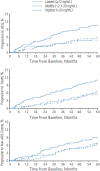Vitamin D, bone, and HIV infection
- PMID: 23363695
- PMCID: PMC4019218
Vitamin D, bone, and HIV infection
Abstract
Vitamin D deficiency has been associated with increased risk for falls and fractures, diabetes and obesity, cardiovascular disease, some malignancies, and tuberculosis. Observational data have suggested benefit of higher vitamin D levels in many of these settings. However, data from randomized trials supporting the benefit of vitamin D supplementation are generally lacking, apart from data showing benefit in preventing falls and fractures in the elderly. HIV-infected persons have a high prevalence of vitamin D deficiency and insufficiency, and some antiretroviral drugs are known to interfere with vitamin D metabolism. However, as in the general population, there are currently few data from clinical trials to identify benefits of vitamin D screening and supplementation in the HIV-infected population. A rational approach is to screen at-risk patients (eg, those aged 50 years and older and those with osteoporosis, prior fracture, or high risk for falls); supplementation may be considered in specific subgroups of patients. This article summarizes a presentation by Michael Yin, MD, MS, at the IAS-USA live Improving the Management of HIV Disease continuing medical education program held in New York, New York, in October 2012.
Conflict of interest statement
Financial Affiliations: Dr Yin has served as a consultant for Abbott Laboratories and Gilead Sciences, Inc. (Updated 1/10/13)
Figures
Similar articles
-
Vitamin D deficiency in HIV infection: an underestimated and undertreated epidemic.Eur Rev Med Pharmacol Sci. 2013 May;17(9):1218-32. Eur Rev Med Pharmacol Sci. 2013. PMID: 23690192 Review.
-
Vitamin D Deficiency in HIV Infection: Not Only a Bone Disorder.Biomed Res Int. 2015;2015:735615. doi: 10.1155/2015/735615. Epub 2015 Apr 27. Biomed Res Int. 2015. PMID: 26000302 Free PMC article. Review.
-
Challenges in the management of osteoporosis and vitamin D deficiency in HIV infection.Top Antivir Med. 2013 Jul-Aug;21(3):115-8. Top Antivir Med. 2013. PMID: 23981599 Free PMC article. Review.
-
Vitamin D and bone loss in HIV.Curr Opin HIV AIDS. 2016 May;11(3):277-84. doi: 10.1097/COH.0000000000000272. Curr Opin HIV AIDS. 2016. PMID: 26890209 Free PMC article. Review.
-
Vitamin D and the elderly.Clin Endocrinol (Oxf). 2005 Mar;62(3):265-81. doi: 10.1111/j.1365-2265.2005.02226.x. Clin Endocrinol (Oxf). 2005. PMID: 15730407 Review.
Cited by
-
Lifetime and recent alcohol use and bone mineral density in adults with HIV infection and substance dependence.Medicine (Baltimore). 2017 Apr;96(17):e6759. doi: 10.1097/MD.0000000000006759. Medicine (Baltimore). 2017. PMID: 28445303 Free PMC article.
-
Alcohol Consumption and Bone Mineral Density in People with HIV and Substance Use Disorder: A Prospective Cohort Study.Alcohol Clin Exp Res. 2018 Jun 6:10.1111/acer.13801. doi: 10.1111/acer.13801. Online ahead of print. Alcohol Clin Exp Res. 2018. PMID: 29873812 Free PMC article.
References
-
- Bischoff-Ferrari HA, Willett WC, Orav EJ, et al. A pooled analysis of vitamin D dose requirements for fracture prevention. N Engl J Med. 2012;367(1):40-49. - PubMed
-
- Holick MF, Siris ES, Binkley N, et al. Prevalence of Vitamin D inadequacy among postmenopausal North American women receiving osteoporosis therapy. J Clin Endocrinol Metab. 2005;90(6):3215-3224. - PubMed
-
- Dao CN, Patel P, Overton ET, et al. Low vitamin D among HIV-infected adults: prevalence of and risk factors for low vitamin D levels in a cohort of HIV-infected adults and comparison to prevalence among adults in the US general population. Clin Infect Dis. 2011;52:396-405. - PubMed
Publication types
MeSH terms
Substances
Grants and funding
LinkOut - more resources
Full Text Sources
Medical


